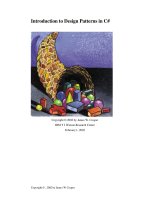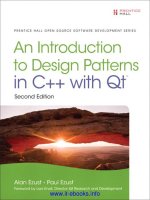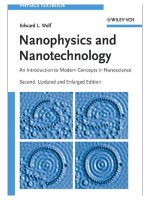An Introduction to Design Patterns in C++ with Qt™, 2nd Edition doc
Bạn đang xem bản rút gọn của tài liệu. Xem và tải ngay bản đầy đủ của tài liệu tại đây (14.24 MB, 766 trang )
ptg7041395
www.it-ebooks.info
ptg7041395
An Introduction to Design
Patterns in C++ with Qt
™
,
2nd Edition
www.it-ebooks.info
ptg7041395
O
pen Source technology has revolutionized the computing world.
From MySQL to the Python programming language, these technologies
are in use on many different systems, ranging from proprietary systems,
to Linux systems, to traditional UNIX systems, to mainframes. The Prentice
Hall Open Source Software Development Series is designed to bring
you the best of these Open Source technologies. Not only will you learn
how to use them for your projects, but you will learn from them. By seeing
real code from real applications, you will learn the best practices of Open
Source developers the world over.
Visit informit.com/opensourcedev for a complete list of available publications.
The Prentice Hall Open Source
Software Development Series
Arnold Robbins, Series Editor
www.it-ebooks.info
ptg7041395
An Introduction to Design
Patterns in C++ with Qt
™
,
2nd Edition
Alan Ezust and Paul Ezust
Upper Saddle River, NJ • Boston • Indianapolis • San Francisco
New York • Toronto • Montreal • London • Munich • Paris • Madrid
Cape Town • Sydney • Tokyo • Singapore • Mexico City
www.it-ebooks.info
ptg7041395
Many of the designations used by manufacturers and sellers to distinguish their products are claimed as trademarks. Where those
designations appear in this book, and the publisher was aware of a trademark claim, the designations have been printed with initial
capital letters or in all capitals.
The authors and publisher have taken care in the preparation of this book, but make no expressed or implied warranty of any kind
and assume no responsibility for errors or omissions. No liability is assumed for incidental or consequential damages in connection
with or arising out of the use of the information or programs contained herein.
The publisher offers excellent discounts on this book when ordered in quantity for bulk purchases or special sales, which may
include electronic versions and/or custom covers and content particular to your business, training goals, marketing focus, and
branding interests. For more information, please contact:
U.S. Corporate and Government Sales
(800) 382-3419
For sales outside the United States please contact:
International Sales
Visit us on the Web: informit.com/ph
Library of Congress Cataloging-in-Publication Data:
Ezust, Alan.
An introduction to design patterns in C++ with QT / Alan Ezust, Paul Ezust. 2nd ed.
p. cm.
Includes bibliographical references and index.
ISBN 978-0-13-282645-7 (hardback : alk. paper)
1. C++ (Computer program language) 2. Software patterns. 3. Computer software Reusability. I. Ezust, Paul. II. Title.
QA76.73.C153E94 2011
005.13’3 dc23
2011018378
Copyright © 2012 Alan and Paul Ezust
All rights reserved. Printed in the United States of America. This publication is protected by copyright, and permission must be
obtained from the publisher prior to any prohibited reproduction, storage in a retrieval system, or transmission in any form or
by any means, electronic, mechanical, photocopying, recording, or likewise. For information regarding permissions, write to:
Pearson Education, Inc
Rights and Contracts Department
501 Boylston Street, Suite 900
Boston, MA 02116
Fax (617) 671-3447
Tu x i s c r e a t e d b y L a r r y E w i n g , l e w i n g @ i s c . t a m u . e d u , u s i n g G I M P.
Qt and the Qt logo are trademarks of Nokia Corporation and/or its subsidiaries in Finland and other countries.
ISBN-13: 978-0-132-82645-7
ISBN-10: 0-132-82645-3
Te x t p r i n t ed i n th e Un i t ed S ta t e s on r e cy c l ed p a p er a t C ou r i e r i n We s t f or d , Ma s s a ch u s e t ts .
First printing September 2011
Editor-in-Chief: Mark Taub
Acquisitions Editor: Debra Williams Cauley
Managing Editor: Kristy Hart
Project Editor: Jovana San Nicolas-Shirley
Copy Editor: Apostrophe Editing Services
Indexer: Cheryl Lenser
Proofreader: Gill Editorial Services
Publishing Coordinator: Kim Boedigheimer
Cover Designer: Alan Clements
Compositor: Nonie Ratcliff
www.it-ebooks.info
ptg7041395
i s b o o k i s d e d i c a t e d t o M i r i a m E z u s t , w i t h o u t
whom none of our work would have been possible.
www.it-ebooks.info
ptg7041395
This page intentionally left blank
www.it-ebooks.info
ptg7041395
vii
Foreword xv
Preface xix
Preface to the Second Edition xxii
Acknowledgments xxv
About the Authors xxx
Part I: Design Patterns and Qt 4 1
Chapter 1: C++ Introduction 3
1.1 Overview of C++ 3
1.2 A Brief History of C++ 4
1.3 C++ First Example 5
1.4 Standard Input and Output 8
1.5 Introduction to Functions 11
1.6 qmake, Project Files, and Makefile 17
1.7 Getting Help Online 24
1.8 Strings 24
1.9 Streams 26
1.10 File Streams 29
1.11 Qt Dialogs for User Input/Output 34
1.12 Identifiers, Types, and Literals 37
1.13 C++ Simple Types 40
1.14 The Keyword const 52
1.15 Pointers and Memory Access 54
Contents
www.it-ebooks.info
ptg7041395
1.16 Reference Variables 60
1.17 const* and *const 61
1.18 Review Questions 64
Chapter 2: Top of the class 67
2.1 First, There Was struct 67
2.2 Class Definitions 69
2.3 Member Access Specifiers 71
2.4 Encapsulation 74
2.5 Introduction to UML 75
2.6 Friends of a Class 76
2.7 Constructors 77
2.8 Destructors 80
2.9 The Keyword static 81
2.10 Class Declarations and Definitions 86
2.11 Copy Constructors and Assignment Operators 88
2.12 Conversions 92
2.13 const Member Functions 95
2.14 Subobjects 97
2.15 Exercise: Classes 98
2.16 Review Questions 108
Chapter 3: Introduction to Qt 113
3.1 Style Guidelines, Naming Conventions 114
3.2 The Qt Core Module 116
3.3 QtCreator—An IDE for Qt Programming 119
3.4 Exercises: Introduction to Qt 120
3.5 Review Questions 121
Chapter 4: Lists 122
4.1 Introduction to Containers 122
4.2 Iterators 123
4.3 Relationships 129
viii An Introduction to Design Patterns in C++ with Qt™, 2nd Edition
www.it-ebooks.info
ptg7041395
4.4 Exercise: Relationships 132
4.5 Review Questions 134
Chapter 5: Functions 135
5.1 Overloading Functions 135
5.2 Optional Arguments 138
5.3 Operator Overloading 141
5.4 Parameter Passing by Value 146
5.5 Parameter Passing by Reference 148
5.6 References to const 152
5.7 Function Return Values 154
5.8 Returning References from Functions 154
5.9 Overloading on const 155
5.10 inline Functions 158
5.11 Functions with Variable-Length Argument Lists 162
5.12 Exercise: Encryption 164
5.13 Review Questions 167
Chapter 6: Inheritance and Polymorphism 168
6.1 Simple Derivation 168
6.2 Derivation with Polymorphism 177
6.3 Derivation from an Abstract Base Class 184
6.4 Inheritance Design 189
6.5 Overloading, Hiding, and Overriding 191
6.6 Constructors, Destructors, and Copy Assignment Operators 193
6.7 Processing Command-Line Arguments 198
6.8 Containers 204
6.9 Managed Containers, Composites, and Aggregates 206
6.10 Containers of Pointers 210
6.11 Review Questions 228
Chapter 7: Libraries and Design Patterns 234
7.1 Building and Reusing Libraries 236
7.2 Exercise: Installing Libraries 244
Contents ix
www.it-ebooks.info
ptg7041395
7.3 Frameworks and Components 247
7.4 Design Patterns 248
7.5 Review Questions 257
Chapter 8: QObject, QApplication, Signals, and Slots 259
8.1 Values and Objects 263
8.2 Composite Pattern: Parents and Children 264
8.3 QApplication and the Event Loop 272
8.4 Q_OBJECT and moc: A checklist 274
8.5 Signals and Slots 275
8.6 QObject Lifecycle 277
8.7 QTestLib 277
8.8 Exercises: QObject, QApplication, Signals, and Slots 282
8.9 Review Questions 282
Chapter 9: Widgets and Designer 283
9.1 Widget Categories 284
9.2 Designer Introduction 286
9.3 Dialogs 290
9.4 Form Layout 292
9.5 Icons, Images, and Resources 295
9.6 Layout of Widgets 298
9.7 Designer Integration with Code 306
9.8 Exercise: Input Forms 313
9.9 The Event Loop: Revisited 314
9.10 Paint Events, Drawing Images 323
9.11 Review Questions 325
Chapter 10: Main Windows and Actions 326
10.1 QActions, QMenus, and QMenuBars 327
10.2 Regions and QDockWidgets 337
10.3 QSettings: Saving and Restoring Application State 339
10.4 Clipboard and Data Transfer Operations 341
x An Introduction to Design Patterns in C++ with Qt™, 2nd Edition
www.it-ebooks.info
ptg7041395
10.5 The Command Pattern 343
10.6 tr() and Internationalization 351
10.7 Exercises: Main Windows and Actions 352
10.8 Review Questions 353
Chapter 11: Generics and Containers 355
11.1 Generics and Templates 355
11.2 Generics, Algorithms, and Operators 362
11.3 Sorted Map Example 365
11.4 Function Pointers and Functors 368
11.5 Flyweight Pattern: Implicitly Shared Classes 371
11.6 Exercise: Generics 375
11.7 Review Questions 376
Chapter 12: Meta Objects, Properties, and Reflective Programming 378
12.1 QMetaObject—The MetaObject Pattern 378
12.2 Type Identification and qobject_cast 380
12.3 Q_PROPERTY Macro—Describing QObject Properties 383
12.4 QVariant Class: Accessing Properties 386
12.5 Dynamic Properties 389
12.6 MetaTypes, Declaring, and Registering 394
12.7 invokeMethod() 396
12.8 Exercises: Reflection 397
12.9 Review Questions 397
Chapter 13: Models and Views 399
13.1 Model-View-Controller (MVC) 400
13.2 Qt Models and Views 402
13.3 Table Models 414
13.4 Tree Models 424
13.5 Smarter Pointers 429
13.6 Exercises: Models and Views 431
13.7 Review Questions 433
Contents xi
www.it-ebooks.info
ptg7041395
Chapter 14: Validation and Regular Expressions 434
14.1 Input Masks 435
14.2 Validators 438
14.3 Regular Expressions 440
14.4 Regular Expression Validation 449
14.5 Subclassing QValidator 451
14.6 Exercises: Validation and Regular Expressions 454
14.7 Review Questions 456
Chapter 15: Parsing XML 457
15.1 The Qt XML Parsers 460
15.2 SAX Parsing 462
15.3 XML, Tree Structures, and DOM 466
15.4 XML Streams 476
15.5 Review Questions 479
Chapter 16: More Design Patterns 481
16.1 Creational Patterns 481
16.2 Memento Pattern 491
16.3 Façade Pattern 498
16.4 Review Questions 505
Chapter 17: Concurrency 506
17.1 QProcess and Process Control 506
17.2 QThread and QtConcurrent 522
17.3 Exercises: QThread and QtConcurrent 536
17.4 Review Questions 537
Chapter 18: Database Programming 539
18.1 QSqlDatabase: Connecting to SQL from Qt 541
18.2 Queries and Result Sets 546
18.3 Database Models 548
18.4 Review Questions 549
xii An Introduction to Design Patterns in C++ with Qt™, 2nd Edition
www.it-ebooks.info
ptg7041395
Part II: C++ Language Reference 550
Chapter 19: Types and Expressions 552
19.1 Operators 553
19.2 Statements and Control Structures 557
19.3 Evaluation of Logical Expressions 564
19.4 Enumerations 565
19.5 Signed and Unsigned Integral Types 567
19.6 Standard Expression Conversions 570
19.7 Explicit Conversions 574
19.8 Safer Typecasting Using ANSI C++ Typecasts 574
19.9 Overloading Special Operators 581
19.10 Runtime Type Identification 587
19.11 Member Selection Operators 590
19.12 Exercises: Types and Expressions 592
19.13 Review Questions 594
Chapter 20: Scope and Storage Class 595
20.1 Declarations and Definitions 595
20.2 Identifier Scope 597
20.3 Storage Class 606
20.4 Namespaces 610
20.5 Review Questions 615
Chapter 21: Memory Access 617
21.1 Pointer Pathology 618
21.2 Further Pointer Pathology with Heap Memory 620
21.3 Memory Access Summary 623
21.4 Introduction to Arrays 624
21.5 Pointer Arithmetic 626
21.6 Arrays, Functions, and Return Values 627
21.7 Different Kinds of Arrays 629
Contents xiii
www.it-ebooks.info
ptg7041395
21.8 Valid Pointer Operations 629
21.9 Arrays and Memory: Important Points 632
21.10 Exercises: Memory Access 633
21.11 Review Questions 634
Chapter 22: Inheritance in Detail 635
22.1 virtual Pointers, virtual Tables 635
22.2 Polymorphism and virtual Destructors 638
22.3 Multiple Inheritance 642
22.4 public, protected, and private Derivation 650
22.5 Review Questions 652
Part III: Programming Assignments 653
Chapter 23: MP3 Jukebox Assignments 655
23.1 Phonon/MultiMediaKit Setup 657
23.2 Playlist 657
23.3 Playlists 658
23.4 Source Selector 659
23.5 Database Playlists 661
23.6 Star Delegates 661
23.7 Sorting, Filtering, and Editing Playlists 661
Appendix A: C++ Reserved Keywords 662
Appendix B: Standard Headers 664
Appendix C: Development Tools 666
Appendix D: Alan’s Quick Start Guide to Debian for Programmers 691
Appendix E: C++/Qt Setup 698
Bibliography 706
Index 709
xiv An Introduction to Design Patterns in C++ with Qt™, 2nd Edition
www.it-ebooks.info
ptg7041395
xv
Foreword
I still remember how I rst got to know C++ and Qt. It was around 15 years ago while
working on my diploma thesis. Most of the development we did at that time was done
in Fortran and C. I was working on a Linux system with FVWM as a window man-
ager. One day I read an article about KDE—a cool, new open source project to create
a desktop environment for Linux. Being not really happy with the user interface that
Linux had to oer, I went to download, compile, and install the package.
KDE used Qt as the underlying framework. After some time as a user, I started
contributing to the KDE project. Although I had studied object-oriented programming
at university, it was only when I started developing for KDE with Qt that I really
learned and understood many of the concepts.
C++ as a programming language is in some ways incomplete. Most other languages
such as Java, Python, or C# come with a rather complete set of frameworks. e scope
of the C++ standard library is, however, limited to low-level functionality, containers,
and algorithms.
Combining a powerful and complex language such as C++ with a standard library
that is limited in scope but makes extensive use of all the advanced features of C++
creates an extremely steep learning curve for developers who want to start developing
in C++.
i s i s w h e r e Q t c a n h e l p . Q t i s a c o m p r e h e n s i v e , h i g h - q u a l i t y f r a m e w o r k f o r
professional application development. It covers most of the functionality that is missing
from the standard library, such as threading, Unicode support, XML handling, and
most important, ways to create graphical user interfaces (GUIs).
When I did my rst bits of coding in C++, I was using Qt. Qt made it easy for me
to start on my rst projects and made it easy to learn new concepts of the C++ language
while developing real applications. It was actually a lot of fun to work with Qt, so I
soon migrated all my work from other languages to using Qt and C++.
Qt has always focused on trying to provide an intuitive and easy-to-use API set. e
focus of the framework has always been on helping application developers to get their
work done. is focus has, however, often led to rather clean implementations of
www.it-ebooks.info
ptg7041395
xvi An Introduction to Design Patterns in C++ with Qt™, 2nd Edition
certain design patterns. e signal/slot mechanism, for example, makes object-
oriented programming extremely easy and intuitive.
i s b o o k t r i e s t o t e a c h C + + a n d Q t t o g e t h e r . W i t h Q t , c r e a t i n g v i s i b l e r e s u l t s i s
easy, usually only requiring a few lines of code. is helps overcome the complexity
of C++ as a language, makes learning it more enjoyable, and motivates students to
continue learning.
To b ec om e a g o od n ov e l is t, o ne m us t r st re ad m an y g o od n ov e ls . To b ec om e a
good composer, one must rst listen to good music. e same thing applies to
software developers. Working with an expertly designed library is important to
becoming a good software developer. Having the source code for this library available
helps developers understand many details, and it can be a place to nd inspiration
and maybe even solutions to some problems. Qt being LGPL
1
licensed makes this
source code available to everybody.
Every C++ student should learn the language in conjunction with Qt. is book
is committed to bringing this synergy to students. Qt users tend to be passionate
about the framework, and Paul and Alan Ezust are no exception. is second edition
of their book covers even more Qt technologies with more screenshots of the
developed applications.
Learning application development has never been easier than it is today. Qt
comes in an all-encompassing and integrated free package that provides an integrated
development environment (IDE), a compiler, a debugger, the Qt library, tools, and
documentation with tons of examples and demos.
Previously, many emerging software developers got stuck along the way because
there was no proper guidance or the result of the hard coding work was not rewarding
enough. With Qt you can create more with less coding. Bringing your software onto
another platform like a mobile phone, embedded hardware, Mac, Windows, Linux
desktop, and others is only a recompile away. e people who build Qt do everything
possible to make developers’ lives as easy as possible. Alan and Paul’s book can give
you, the developer, the guidance you need.
We hope that you enjoy the journey to becoming a C++ developer [who can] one
day contribute to KDE or one of the many other open source projects using Qt.
Maybe you can write Qt software for a living, as many thousands of developers do
1
GNU Lesser General Public License
www.it-ebooks.info
ptg7041395
Foreword xvii
today. e opportunity is there—the number of jobs for skilled Qt engineers is
increasing every year.
i s t e x t i s n o t o n l y f o r t h o s e n e w t o C + + a n d Q t . E x p e r i e n c e d s o f t w a r e
developers can also obtain much value from the many surprising new ideas contained
in Paul and Alan’s work. e book also serves as a good lookup resource due to the
large index.
To d ay Q t d e ve lo pm en t t a k es p l a ce i n t h e o p en w it h b o t h Q t’s o wn e n g in ee r s a n d
the large community of contributors working on the same code repository. We hope
one day you will contribute code to Qt or add to the Qt ecosystem in another way
as Paul and Alan have done with this excellent new book.
—Lars Knoll
Director of Qt Research and Development
www.it-ebooks.info
ptg7041395
This page intentionally left blank
www.it-ebooks.info
ptg7041395
xix
P r e f a c e
C++ had been in use for many years before it was standardized in 1989, which
makes it a relatively mature language compared to others in popular use today. It is
an important language for building fast, ecient, mission-critical systems. C++ is
also one of the most exible languages around, giving developers many choices of
programming styles for uses ranging from high-level GUI code to low-level device
drivers.
For a few years in the early 90s, C++ was the most popular object-oriented (OO)
language in use, and many computer science (CS) students were introduced to
object-oriented programming (OOP) via C++. is was because C++ provided a
relatively easy transition to OOP for C programmers, and many CS professors had
been teaching C previously.
Starting around 1996, Java gained favor over C++ as the rst OO language for
students to learn. ere are a number of reasons that Java gained so much
popularity.
• T h e l a n g u a g e i t s e l f i s s i m p l e r t h a n C + + .
• The language has built-in garbage collection, so programmers do not need
to concern themselves with memory deallocation.
• A standard set of GUI classes is included in the development kit.
• T h e b u i l t - i n S t r i n g c l a s s s u p p o r t s U n i c o d e .
• M u l t i t h r e a d i n g i s b u i l t i n t o t h e l a n g u a g e .
• It is easier to build and “plug in” Java Archives (JARs) than it is to recompile
and relink libraries.
• Many Web servers provide Java application programming interfaces (APIs)
for easy integration.
• Java programs are platform independent (Wintel, Solaris, MacOS, Linux,
*nix, etc.).
www.it-ebooks.info
ptg7041395
xx An Introduction to Design Patterns in C++ with Qt, 2nd Edition
Many of these benets can be achieved with C++ used with Qt.
• Qt provides a comprehensive set of GUI classes that run faster, look better,
and are more flexible than Java’s Swing classes.
• Signals and slots are easier to use than (Action|Event|Key)Listener inter-
faces in Java.
• Qt has a plugin architecture that makes it possible to load code into an ap-
plication without recompiling or relinking.
• Q t p r o v i d e s foreach , which makes iteration through collections simpler to
read and write.
Although Qt does not provide garbage collection, it provides a variety of alterna-
tives you can use to avoid the need to delete heap objects directly:
• Containers (see Section 6.8 ) that support reference counting and copy on
write
• Parents and children (see Section 8.2 )
• QPointer , and QSharedPointer , and QWeakReference (see Section 19.11 ).
• Subobjects (see Section 2.14 )
• Stack objects (see Section 20.3 )
Using C++ with Qt comes close to (and sometimes exceeds) Java in ease of use,
comprehensiveness, and convenience. It signicantly exceeds Java in the areas of
speed and eciency, making everything from processing-intensive server applica-
tions to high-speed graphics-intensive games possible.
A n o t h e r b e n e t o f l e a r n i n g C + + w i t h Q t c o m e s f r o m Q t ’ s w i d e s p r e a d u s e i n
open source projects. ere is already a great wealth of free open source code that
you can learn from, reuse, and perhaps help to improve.
How to Use This Book
Part I contains the meat of the course: introduction to C++, UML, Qt core,
QObjects, Widgets, Model-View, SQL, XML, and design patterns. is Part is
designed to avoid forward referencing as much as possible, and it presents the topics
in an order and a level of detail that should not overwhelm someone who is new to
C/C++.
www.it-ebooks.info
ptg7041395
Preface xxi
For completeness and for reference, Part II covers in more depth some of the
“dry” but important C++ features that were introduced in Part I . By the time you
have reached this point, these ideas should be a lot easier to understand.
At the end of each chapter, you will nd exercises and review questions. Most of
the programming exercises have solutions available to instructors on our Web site.
For the questions, if the answers are not in the preceding chapter, then often there
are pointers on where to nd them. If this book is used for a course, these questions
could be asked by the student or by the teacher, in the classroom or on an exam.
A Note About Formats
What you are reading now is only one of a number of possible versions available. Because the
document was originally written in XML, using a “literal programming” style, we can generate
a variety of different versions (bulleted slides, paragraphed textbook, with or without solu-
tions, etc.) in a variety of different formats (HTML, pdf, ps, htmlhelp).
Each programming example is extracted from working source code. The Web version provides
a hyperlink from each code excerpt to its full source le. This makes it easy to try the examples
yourself. The text and listings in the Web version also contain hyperlinks from each library
ClassName to its class documentation page.
www.it-ebooks.info
ptg7041395
P r e f a c e t o t h e S e c o n d E d i t i o n
It is hard to know when a book is “nished,” especially when writing about a subject
(Qt) that is also under constant development. So, like Qt, our book has been under
constant development since its conception.
Since the publication of the rst edition, Trolltech released Qt 4.2, Nokia pur-
chased Trolltech, Nokia released Qt 4.7.3, and Alan became a Nokia Certied Qt
Specialist.
In the second edition, there are improvements in every chapter. Many eyeballs
have scrutinized it, and we have rewritten a number of examples and explanations.
We have added new exercises and review questions, some with handouts and
solutions.
e r s t p a r t o f t h e b o o k h a s b e e n r e a r r a n g e d t o i n t r o d u c e Q t e a r l i e r t h a n b e f o r e .
We decided to take advantage of some of Qt’s static convenience functions to write
simple dialog-based applications prior to fully covering classes, functions, etc. File
Streams have also been introduced earlier so that we could present more interesting
examples and assignments.
Widgets, Main Windows, Models and Views, Reection, reads, and Databases
have all been rewritten to use new classes that have been added to Qt since our rst
edition went to press. e Models and Views chapter has been revised and now explains
the use of Delegates,
QXmlStreamReader , QStandardItemModel , QFileSystemModel ,
QColumnView , sorting and ltering, cut and paste, and drag and drop.
e s e c t i o n o n t h r e a d s h a s b e e n c o m p l e t e l y r e w r i t t e n t o h i g h l i g h t t h e a d v a n t a g e s
of using QtConcurrent algorithms rather than managing the Qreads directly from
your code.
e D y n a m i c F o r m s c h a p t e r i s g o n e . I n s t e a d , w e s h o w h o w t o d e s i g n f o r m s
manually and with the assistance of QtCreator/Designer, pointing out various tech-
niques of integrating designer forms with user code.
xxii
www.it-ebooks.info
ptg7041395
Preface to the Second Edition xxiii
e m e d i a p l a y e r e x a m p l e s a n d e x e r c i s e s h a v e b e e n r e w r i t t e n t o u s e Phonon .
1
e F i l e V i s i t o r e x a m p l e , w h i c h w a s o r i g i n a l l y d e v e l o p e d b a c k i n t h e Q t 3 d a y s ,
has outlived its usefulness now that we have QDirIterator . e section on Iteration
is new, and there is no longer a section devoted to the rarely used Visitor pattern.
Instead, we emphasize the Iterator pattern.
Some classes we placed in our libraries have been simplied or adapted to use the
capabilities of the newest Qt components. We show new smart and shared pointers
and how to use them.
More design patterns have been introduced and described. For each pattern, we
have either provided an implementation (perhaps as an exercise) or, where appropri-
ate, we have pointed out the Qt classes that implement or use the pattern.
Tips and best practices have been taken from various sources, including Nokia’s
ocial Qt training material, and are made available to you here. All of the examples
in this edition have been tested with Qt 4.7.
1
Make sure that the libphonon-dev package has been installed if you plan to work with those materials.
www.it-ebooks.info
ptg7041395
This page intentionally left blank
www.it-ebooks.info









